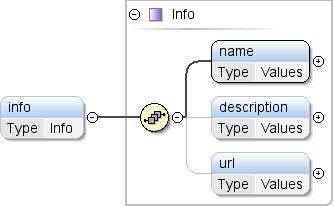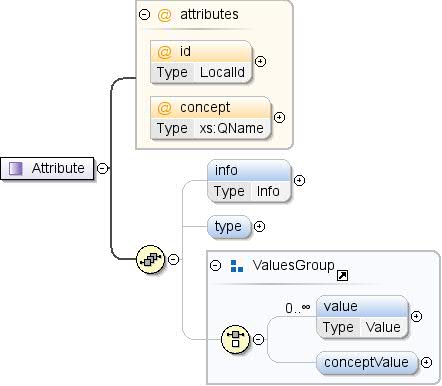元素:属性 / 信息
| 命名空间 | http://schemas.google.com/dspl/2010 | ||||
|---|---|---|---|---|---|
| 注释 | 有关属性的文本信息。 | ||||
| 图示 |  |
||||
| 类型 | 信息 | ||||
| 属性 |
|
||||
| 模型 | name、description{0,1}、url{0,1} | ||||
| 儿童 | description、name、url | ||||
| 实例 |
<info>
<name>{1,1}</name>
<description>{0,1}</description>
<url>{0,1}</url>
</info>
|
||||
| 来源 |
<xs:element name="info" type="Info" minOccurs="0">
<xs:annotation>
<xs:documentation>Textual information about the attribute.</xs:documentation>
</xs:annotation>
</xs:element>
|
元素:属性 / 类型
| 命名空间 | http://schemas.google.com/dspl/2010 | ||||||||||||||||||
|---|---|---|---|---|---|---|---|---|---|---|---|---|---|---|---|---|---|---|---|
| 注释 | 属性的数据类型。 | ||||||||||||||||||
| 图示 |  |
||||||||||||||||||
| 属性 |
|
||||||||||||||||||
| 属性 |
|
||||||||||||||||||
| 来源 |
<xs:element name="type" minOccurs="0">
<xs:annotation>
<xs:documentation>The data type of the attribute.</xs:documentation>
</xs:annotation>
<xs:complexType>
<xs:attribute name="ref" type="DataType" use="required"/>
<xs:attribute name="format" type="xs:string" use="optional">
<xs:annotation>
<xs:documentation>A format for the value, used to parse a textual
representation of the values. See [Date formats spec]
for dates.</xs:documentation>
</xs:annotation>
</xs:attribute>
</xs:complexType>
</xs:element>
|
复杂类型:属性
| 命名空间 | http://schemas.google.com/dspl/2010 | ||||||||||||||||||
|---|---|---|---|---|---|---|---|---|---|---|---|---|---|---|---|---|---|---|---|
| 注释 | 数据集或概念的属性。 | ||||||||||||||||||
| 图示 |  |
||||||||||||||||||
| 使用者 |
|
||||||||||||||||||
| 模型 | info{0,1}、type{0,1}、(value* | conceptValue{0,1}) | ||||||||||||||||||
| 儿童 | conceptValue、info、type、value | ||||||||||||||||||
| 属性 |
|
||||||||||||||||||
| 来源 |
<xs:complexType name="Attribute">
<xs:annotation>
<xs:documentation>An attribute of a dataset or a concept.</xs:documentation>
</xs:annotation>
<xs:sequence>
<xs:element name="info" type="Info" minOccurs="0">
<xs:annotation>
<xs:documentation>Textual information about the attribute.</xs:documentation>
</xs:annotation>
</xs:element>
<xs:element name="type" minOccurs="0">
<xs:annotation>
<xs:documentation>The data type of the attribute.</xs:documentation>
</xs:annotation>
<xs:complexType>
<xs:attribute name="ref" type="DataType" use="required"/>
<xs:attribute name="format" type="xs:string" use="optional">
<xs:annotation>
<xs:documentation>A format for the value, used to parse a textual
representation of the values. See [Date formats spec]
for dates.</xs:documentation>
</xs:annotation>
</xs:attribute>
</xs:complexType>
</xs:element>
<xs:group ref="ValuesGroup" minOccurs="0"/>
</xs:sequence>
<xs:attribute name="id" type="LocalId" use="optional">
<xs:annotation>
<xs:documentation>The id of the concept attribute. This identifier must be unique within the concept
(across attributes and properties).
The id may be omitted if the concept attribute is specified. In that case, an id is
implicity created with value the local name of the referenced concept. For instance
<attribute concept="unit:currency"/>
is equivalent to
<attribute id="currency" concept="unit:currency"/></xs:documentation>
</xs:annotation>
</xs:attribute>
<xs:attribute name="concept" type="xs:QName" use="optional">
<xs:annotation>
<xs:documentation>A reference to a concept that corresponds to the values of the attribute.
If the attribute specifies a type, then the type must match the type of
the referenced concept.
A reference to an external concept must be of the form "prefix:other_concept_id",
where "prefix" is the prefix used for the namespace of the external dataset
(see XML namespaces).</xs:documentation>
</xs:annotation>
</xs:attribute>
</xs:complexType>
|
属性:Attribute / type / @ref
| 命名空间 | 没有命名空间 | ||||||||||||||||||
|---|---|---|---|---|---|---|---|---|---|---|---|---|---|---|---|---|---|---|---|
| 类型 | DataType | ||||||||||||||||||
| 属性 |
|
||||||||||||||||||
| 分面 |
|
||||||||||||||||||
| 使用者 |
|
||||||||||||||||||
| 来源 |
<xs:attribute name="ref" type="DataType" use="required"/> |
属性:Attribute / type / @format
| 命名空间 | 没有命名空间 | ||
|---|---|---|---|
| 注释 | 值的格式,用于解析值的文本表示形式。如需了解日期,请参阅 [日期格式规范]。 | ||
| 类型 | xs:string | ||
| 属性 |
|
||
| 使用者 |
|
||
| 来源 |
<xs:attribute name="format" type="xs:string" use="optional">
<xs:annotation>
<xs:documentation>A format for the value, used to parse a textual
representation of the values. See [Date formats spec]
for dates.</xs:documentation>
</xs:annotation>
</xs:attribute>
|
属性:Attribute / @id
| 命名空间 | 没有命名空间 | |||
|---|---|---|---|---|
| 注释 | 概念属性的 ID。此标识符在概念中必须是唯一的(在属性和属性之间)。如果指定了概念属性,则可以省略 ID。在这种情况下,系统会使用所引用概念的本地名称值隐式创建 ID。 例如,<attribute concept="unit:currency"/> 等同于 <attribute id="currency" concept="unit:currency"/> | |||
| 类型 | LocalId | |||
| 属性 |
|
|||
| 分面 |
|
|||
| 使用者 |
|
|||
| 来源 |
<xs:attribute name="id" type="LocalId" use="optional">
<xs:annotation>
<xs:documentation>The id of the concept attribute. This identifier must be unique within the concept
(across attributes and properties).
The id may be omitted if the concept attribute is specified. In that case, an id is
implicity created with value the local name of the referenced concept. For instance
<attribute concept="unit:currency"/>
is equivalent to
<attribute id="currency" concept="unit:currency"/></xs:documentation>
</xs:annotation>
</xs:attribute>
|
属性:Attribute / @concept
| 命名空间 | 没有命名空间 | ||
|---|---|---|---|
| 注释 | 对与属性的值对应的概念的引用。如果该属性指定类型,则该类型必须与所引用概念的类型相匹配。对外部概念的引用必须采用“prefix:other_concept_id”形式,其中“prefix”是用于外部数据集命名空间的前缀(请参阅 XML 命名空间)。 | ||
| 类型 | xs:QName | ||
| 属性 |
|
||
| 使用者 |
|
||
| 来源 |
<xs:attribute name="concept" type="xs:QName" use="optional">
<xs:annotation>
<xs:documentation>A reference to a concept that corresponds to the values of the attribute.
If the attribute specifies a type, then the type must match the type of
the referenced concept.
A reference to an external concept must be of the form "prefix:other_concept_id",
where "prefix" is the prefix used for the namespace of the external dataset
(see XML namespaces).</xs:documentation>
</xs:annotation>
</xs:attribute>
|
使用 oXygen XML 编辑器创建。
